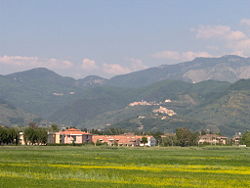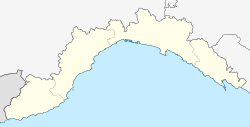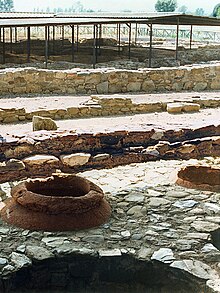
Liguria is a region of north-western Italy; its capital is Genoa. Its territory is crossed by the Alps and the Apennines mountain range and is roughly coextensive with the former territory of the Republic of Genoa. Liguria is bordered by France to the west, Piedmont to the north, and Emilia-Romagna and Tuscany to the east. It rests on the Ligurian Sea, and has a population of 1,557,533. The region is part of the Alps–Mediterranean Euroregion.

The Ligures or Ligurians were an ancient people after whom Liguria, a region of present-day north-western Italy, is named.

Carrara is a town and comune in Tuscany, in central Italy, of the province of Massa and Carrara, and notable for the white or blue-grey marble quarried there. It is on the Carrione River, some 100 kilometres (62 mi) west-northwest of Florence. Its motto is Fortitudo mea in rota.

The Lunigiana or Lunesana is a historical territory of Italy, which today falls within the provinces of Massa Carrara, Tuscany, and La Spezia, Liguria. Its borders derive from the ancient Roman settlement, later the medieval diocese of Luni, which no longer exists.
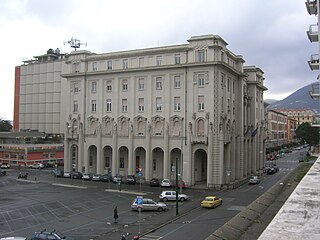
The province of La Spezia is a province in the Liguria region of Italy. Its capital is the city of La Spezia.
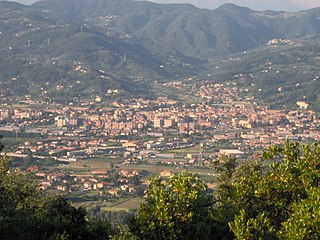
Sarzana is a town, comune (municipality) and former short-lived Catholic bishopric in the Province of La Spezia, Liguria, Italy. It is 15 kilometres (9 mi) east of La Spezia, on the railway to Pisa, at the point where the railway to Parma diverges to the north. In 2010, it had a population of 21,978.

The Magra is a 62-kilometre (39 mi) long river of Northern Italy, which runs through Pontremoli, Filattiera, Villafranca in Lunigiana and Aulla in the province of Massa-Carrara (Tuscany); Santo Stefano di Magra, Vezzano Ligure, Arcola, Sarzana and Ameglia in the province of La Spezia (Liguria).
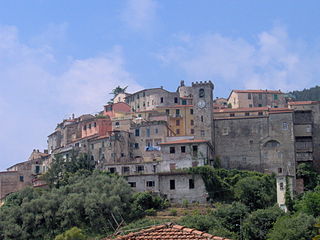
Ameglia is a comune (municipality) in the Province of La Spezia in the Italian region of Liguria, located about 90 kilometres (56 mi) southeast of Genoa and about 11 kilometres (7 mi) southeast of La Spezia.

Beverino is a comune (municipality) of c. 2,000 inhabitants in the province of La Spezia in the Italian region Liguria, located about 70 kilometres (43 mi) southeast of Genoa and about 11 kilometres (7 mi) north of La Spezia. It is part of the Vara river and of the Regional natural Park of Montemarcello-Magra.

Brugnato is a comune (municipality) in the Province of La Spezia in the Italian region Liguria, located about 70 kilometres (43 mi) southeast of Genoa and about 15 km northwest of La Spezia. As of 31 December 2004, it had a population of 1,205 and an area of 12.0 square kilometres (4.6 sq mi). It borders the following municipalities: Borghetto di Vara, Rocchetta di Vara, Sesta Godano, Zignago.

Castelnuovo Magra is a comune (municipality) in the Province of La Spezia in the Italian region Liguria, located about 90 kilometres (56 mi) southeast of Genoa and about 15 kilometres (9 mi) east of La Spezia.
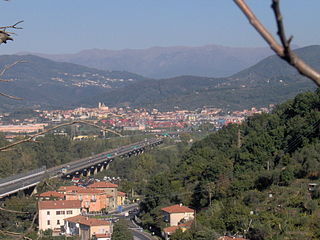
Santo Stefano di Magra is a comune (municipality) in the Province of La Spezia in the Italian region Liguria, located about 80 kilometres (50 mi) southeast of Genoa and about 11 kilometres (7 mi) northeast of La Spezia. It is located near the confluence of torrent Vara into the Magra river. It is part of the Montemarcello-Magra Natural Regional Park. It has an entrance and exit to the toll-paying "Autostrada"
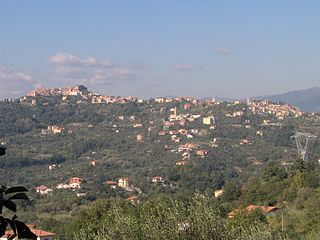
Vezzano Ligure, is a comune (municipality) in the Province of La Spezia in the Italian region of Liguria, located about 80 kilometres (50 mi) southeast of Genoa and about 7 kilometres (4 mi) northeast of La Spezia.

Fosdinovo is a comune (municipality) in the Province of Massa and Carrara in the Italian region Tuscany, located about 110 kilometres (68 mi) northwest of Florence and about 15 kilometres (9 mi) northwest of Massa.
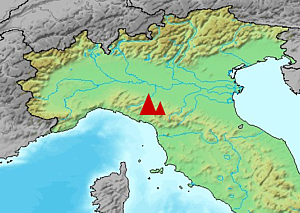
The Apuani were one of the most formidable and powerful of the Ligurian tribes who lived in ancient north-western Italy, mentioned repeatedly by Livy. From the circumstances related by him, it appears that they were the most easterly of the Ligurian tribes, who inhabited the lofty group of mountains bordering on Etruria, and appear to have occupied the valleys of the Macra and Ausar. Although they extended eastwards along the chain of the Apennines to the frontiers of the Arretines and the territory of Mutina and Bononia, the upper valley of the Macra about Pontremoli, including the area later known as Lunigiana where the Tuscan towns of Aulla, Fivizzano, Fosdinovo, Villfranca and Pontremoli are now found, and the adjoining Upper Garfagnana and Ligurian districts of Sarzana and La Spezia were their center.

The Diocese of La Spezia-Sarzana-Brugnato is a Latin diocese of the Catholic Church in Liguria, northern Italy, created in 1929. It is a suffragan of the Archdiocese of Genoa.

The Genoa–Pisa railway is one of the trunk lines of the Italian railway network. It runs along the Ligurian coast from Genoa to Pisa through the Riviera di Levante and the Versilia. It passes through the cities of Massa, Carrara and La Spezia. South of Pisa the Pisa–Rome line continues along the Tyrrhenian coast to Rome. The line is double track and is fully electrified at 3,000 V DC. Passenger traffic is managed by Trenitalia.
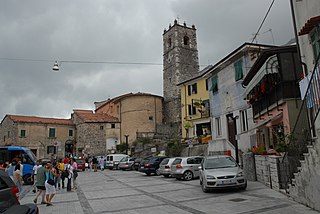
Colonnata is an Italian ancient village and a hamlet (frazione) of the comune of Carrara,. It is situated in the Apuan Alps, and is known worldwide for the pork fat delicacy Lardo di Colonnata, and for its marble quarries.
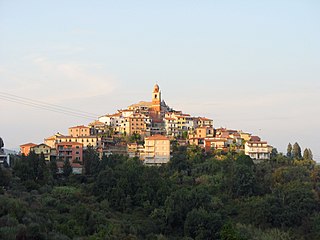
Valeriano Lunense is a village (frazione) of about 500 inhabitants in the comune of Vezzano Ligure in the province of La Spezia, Italy.

Retignano is a village of about 400 inhabitants, located on a hill in the historical Versilia region of Tuscany, Italy. The inhabitants are known as the Retignanesi.
